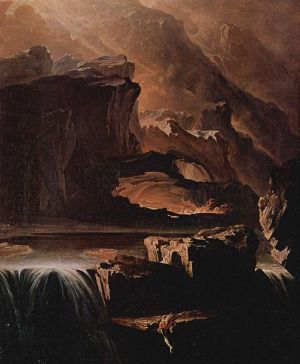Like his other Regency brothers, John Martin (1789 – 1854) strove to break away from his lower-class background and achieve the notice of the ton.
It seemed he had done so when his drawings became much admired by the Princess Charlotte and the Earl of Warwick. However, the former was not known for her taste in art. Despite having taken out a patent for soap, which the Royal Navy found useful as it would not curdle in sea water, his lordship lived in “penury, mortification and wretchedness.”
John was already supporting his older brother William, another tinker of limited success.
What he needed was a well-heeled patron. Drawings and sepia painting on teacups was only a scrambling sort of business.In order to attract such attention, he would have to break out of the current mold of Romantic painters. Constable and others were producing pastoral landscape themes which characterized a good deal of painting during the Regency. John decided to incorporate his father’s thundering Old Testament discourse, and took the “Picturesque” movement in a whole new direction.
Sadak in Search of the Waters of Oblivion was submitted to the Royal Academy in 1812 for display at Somerset House. When the painting arrived, there was some confusion as to which end of the canvas was the top of the painting. For all the initial difficult it posed in the hanging, Sadak was completely ignored. Dejected, John took it away–one has to believe he carried it upside down. Once in his modest lodgings, he saw a calling card had been left in the dingy foyer. It was from a well-connected Governor of the Bank of England, William Manning, and he wanted to purchase the canvas.
As an amusing aside, John’s new patron was also the MP for Plympton Erle. His seat had been previously occupied by the unpopular Earl of Carhampton. This Irish peer had the indignity of reading his own death notice in the paper. Incensed, he demanded it be withdrawn. The paper complied, under the prominent headline, Public Disappointment.
Manning not only replaced an unpopular peer–his purchase encouraged John to continue his theme of vast, wild nature. In these works, appropriately titled Joshua Commanding the Sun to Stand Still upon Gibeon and Fall of Babylon, humans were rendered insignificant beneath glowering clouds. It was called Sublime.
Critics called it bombastic, the worst sort of populist art.
However, the Regency period was experiencing not just a sea change in the style of its arts, but in the nature of the audience. By the time John’s Belshazzar’s Feast was to be exhibited at the British Institution, he had aroused not only the interest of Whig politicians and the Duke of Buckingham, his work was now commanding the attention of the masses. Feast could not be displayed in intimate, hushed surroundings, to be admired only by the wealthy and privileged. A railing had to be erected, to protect the massive painting from the crowds that came to view it.
Even now John Martin’s paintings command astonishment and awe. Just watch this clip from the Tate Britain’s Museum. It had recently exhibited John’s work, entitled Apocalypse.
Does his work seem familiar? Rock bands use his work for their album covers. Movie makers incorporate his vision in theirs.
Bombastic, perhaps. But altogether unforgettable.



His paintings are quite extraordinary. I wonder how he would have felt about them gracing the covers of rock albums.
LikeLike
Yes–that’s an arresting thought. His family was quite severe in their religion and I daresay John was cut from the same cloth.
LikeLike
Oh, those Regency brothers! Another interesting post. They seem so different in their interests , yet so much alike in character. I can see how rock bands would like his paintings as a cover…..very dramatic!
LikeLike
Hope you watched that YouTube clip–a little light show there any rock band could appreciate…
LikeLike
I had no idea that painting went back so far. how forward thinking he was. I tweeted. Angelyn, I tagged you for the Liebster Award. Check it out on my blog.
LikeLike
Thank you for nominating me!
LikeLike
This reminds me of the illustrations by William Blake – and how it would look if he decided to use a brush tinted with sepia.
LikeLike
Yes! His Revelations series come to mind. Thanks for stopping by, Aubrey.
LikeLike
Here’s a belated Valentine for you! The Liebster award. Hope you accept! http://tinyurl.com/d2lx47c
LikeLike
Thank you for the nomination! The second in as many days….
LikeLike
further example of your genius!
LikeLike